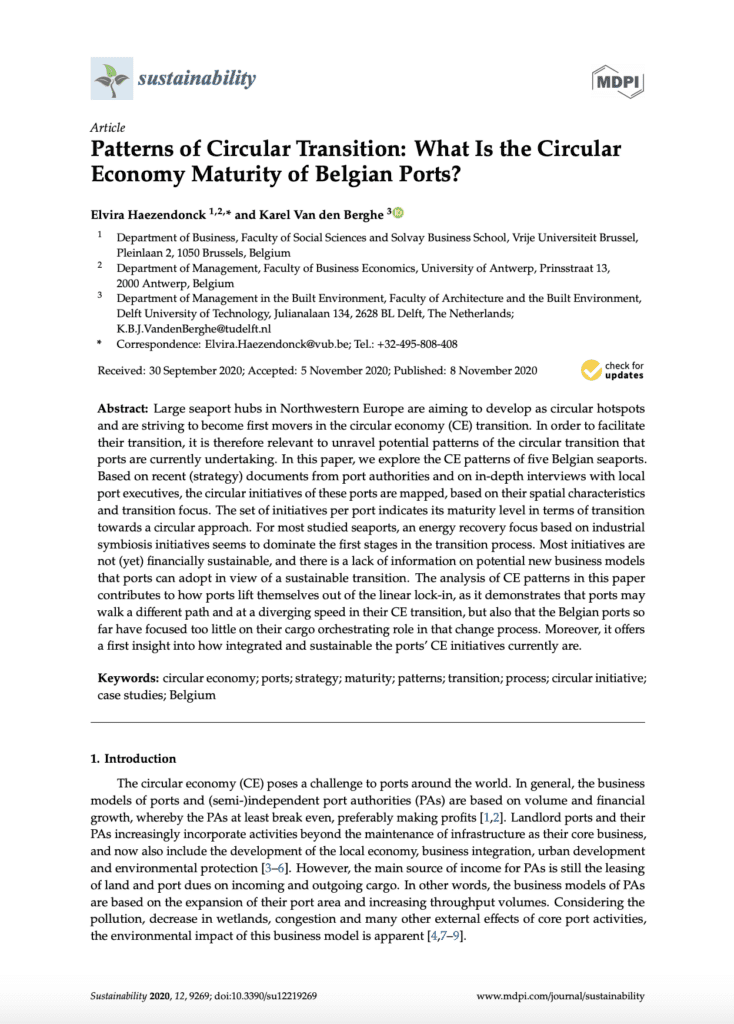-
Seaports will play a key role in the transition to a low-carbon economy.
-
Their central role in the economy and interdependence with industry make them potential hosts for circular innovation.
-
Ports’ circular activities focus on renewable energy and recycling.
Our ports are gateways to the rest of the world, making them key drivers of our country’s economic growth and prosperity. They account for 7% of GDP and nearly 6% of all jobs in Belgium. Less well known is that ports will also play a key role in the transition from a linear to a circular economy. This shift is crucial to reducing CO2 emissions and meeting the Paris climate goals.
Ports have a number of advantages that make them key players in this transition. As hubs for the flow of raw materials, products and waste into our economy, they have great expertise in logistics, storage and waste management. There is often a lot of industry nearby, especially in Antwerp, which has one of the largest petrochemical clusters in the world. In addition, ports close to major cities have easier access to labour and capital. This combination of elements makes ports potential hotspots for circular economy innovation.
Most Belgian ports already have many circular initiatives in place. This is the result of a recent study on the circularity of the ports of Antwerp, Zeebrugge, Ostend, Brussels and Ghent (North Sea Port Flanders).
The Port of Antwerp, the largest port in our country, has the most circular projects with a strong focus on energy. The Port of Antwerp aims to become a “multi-fuel port” by 2025, offering more sustainable alternative fuels in addition to conventional fuels. As the fifth largest bunkering port (a port where ships come to refuel) in the world, the Port of Antwerp plays an important role in the transition to green fuels in shipping. The supply of clean energy is also vital for the chemical companies in and around Antwerp, which use a lot of energy to process raw materials. The Ecluse steam network is a good example of circular industrial cooperation. The incineration of residual waste at Indaver’s waste-to-energy plant produces steam that is piped to other port companies. These companies no longer have to produce their own steam or buy it at a high price.
In the coming years, most ports will switch to hydrogen in order to reduce CO2 emissions. Hydrogen (H2) is a versatile energy carrier. It can be used as a fuel for transport, industry and homes. Or it can be used to store energy. The merger of the ports of Antwerp and Zeebrugge brings together two major energy hubs, making it possible to scale up the production and import of green hydrogen. North Sea Port (the merger of the ports of Ghent, Terneuzen and VLissingen) has many circular projects underway in renewable energy and recycling. The port is one of the European leaders in the production of biofuels and intends to fully explore hydrogen as an energy source in the coming years.
The Port of Oostende is relatively small in terms of cargo handling, but has a number of circular projects underway in the port area. It is the base for the construction and maintenance of several offshore wind farms. There is also a circular economy cluster where waste is turned into new raw materials and scientific research is carried out. The Port of Brussels is traditionally an inland port, but can also receive seagoing vessels. Most circular activities are small-scale and related to waste recycling, while in the other Belgian ports energy and industrial processes are more important.
Clearly, Belgian ports are not lacking in ambition to make the transition to a low-carbon society. However, the challenges are complex and the longer-term financing needs of circular business plans are often difficult to quantify. At least a quarter of ongoing projects rely on subsidies to stay financially afloat. This will not change immediately in the coming years. There is still a lot of work to be done in terms of investing in infrastructure and adapting laws and regulations to complete the circular economy business case.
Sources original article:
NBB Working Paper July 2020, ‘Economic importance of the Belgian maritime and inland ports’.
Haezendonck, E.; Van den Berghe , K; ‘Patterns of Circular Transition: What Is the Circular Economy Maturity of Belgian Ports?’, November, 2020.
www.portofantwerp.com
www.northseaport.com
circularports.vlaanderen-circulair.be
This article De havens als pioniers van de circulaire economie – Belfius by Frank Maet (Senior Macro Economist @Belfiusfirst) and Véronique Goossens (Chief Economist @Belfius) appeared on Belfius News – April 22, 2021.
Image credit: Marco Federmann via Pixabay

